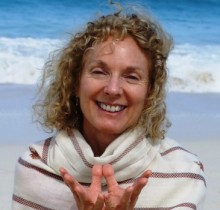 Please help me celebrate the Golden Anniversary of this research and review newsletter with a little Laughter Yoga: Clap your hands as you say, “Very Good! Very good!” Now raise your arms overhead, as you say, “Yay!” Do this a couple of times and then close your eyes and sense deeply into the tingling in your palms. Sense your fingers, your face. The body is always present. The mind is a time traveler, so when you take time to sense into the sensations in your palms, you become the presence you seek. There is a window through whatever mood state is visiting.
Please help me celebrate the Golden Anniversary of this research and review newsletter with a little Laughter Yoga: Clap your hands as you say, “Very Good! Very good!” Now raise your arms overhead, as you say, “Yay!” Do this a couple of times and then close your eyes and sense deeply into the tingling in your palms. Sense your fingers, your face. The body is always present. The mind is a time traveler, so when you take time to sense into the sensations in your palms, you become the presence you seek. There is a window through whatever mood state is visiting.
Did you smile when you practiced? There is evidence that smiling, not to mention laughing, even if you’re faking it, changes your biochemistry, releasing feel-good hormones and raising dopamine levels. And just about everyone enjoys this little laughter yoga break. I’ve used it with seniors, with children, and once during a credit union board meeting in Tucson! Teach it to your kids, your parents, your students and your clients.
In this 50th newsletter, we focus on a study that compares twenty minutes of yoga with aerobic exercise. Turns out that yoga actually improves mental functioning while the same period of exercise does not. We also review two books. First, we’ll look at an important contribution to the the emerging field of yoga therapy, Mudras for Healing and Transformation, written by Integrative Yoga Therapy founders Joseph and Lilian Le Page. Then we’ll review Trauma and the Twelve Steps by Jamie Marich, PhD. Her book makes a case for integrating trauma work into 12-Step Recovery and walks us through how to do it.
For your summer deep rest, renewal and relaxation, we’ll review a new series of iRest Yoga Nidra CDs by Jeanne Dillion, a yoga teacher and student of Richard Miller’s. There’s even a couple of practices to get the kids to sleep!
I hope to meet you on the yoga path this summer!
- Research: Yoga Improves Mental Functioning Better Than Aerobic Exercise
- Review: Trauma and the Twelve Steps: A Complete Guide to Enhancing Recovery by Jamie Marich, PhD
- Review: iRest® – Yoga Nidra for Kids At Bedtime and Quiet Time (CD) by Jeanne Dillion
- Review: Mudras for Healing by Joseph & Lilian Le Page
- News: LifeForce Yoga Launches New Blog
- Events Calendar
Research: Yoga Improves Mental Functioning Better Than Aerobic Exercise
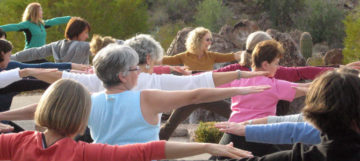 Numerous studies have been featured in the media about the benefits of aerobic exercise for keeping our brains functioning at optimum capacity. Exercise lifts our moods, helps grow telemeres and has been shown to help protect our memories as we age, even more than doing crossword puzzles. The current study by Neha Gothe, PhD, and her colleagues at the University of Illinois, compared a twenty minute yoga protocol that included pranayama breathing and a brief meditation to both vigorous and moderate exercise on a treadmill for the same period of time. While there was no change in the exercise group’s ability to focus and the exercisers capacity to take in, retain and use new information, the yoga practitioners showed significant enhancements in their reaction times and accuracy on cognitive tasks after completing yoga practice.
Numerous studies have been featured in the media about the benefits of aerobic exercise for keeping our brains functioning at optimum capacity. Exercise lifts our moods, helps grow telemeres and has been shown to help protect our memories as we age, even more than doing crossword puzzles. The current study by Neha Gothe, PhD, and her colleagues at the University of Illinois, compared a twenty minute yoga protocol that included pranayama breathing and a brief meditation to both vigorous and moderate exercise on a treadmill for the same period of time. While there was no change in the exercise group’s ability to focus and the exercisers capacity to take in, retain and use new information, the yoga practitioners showed significant enhancements in their reaction times and accuracy on cognitive tasks after completing yoga practice.
Thirty college-age women participated in a 20-minute yoga progression of seated, standing and supine yoga postures, which included isometric contraction and relaxation of different muscle groups and regulated breathing. Finally, the yoga session ended with a meditative posture and deep breathing. The same group of women also took part in an aerobic exercise session that included walking or jogging on a treadmill for 20 minutes, with an objective to maintain 60 to 70 percent of maximum heart rate throughout the exercise session.
Neha Gothe, who is currently a professor of kinesiology, health and sport studies at Wayne State University in Detroit, said yoga seemed to help the participants “…focus their mental resources, process information quickly, more accurately and also learn, hold and update pieces of information more effectively than after performing an aerobic exercise bout.”
This study underscores the theory in LifeForce Yoga that you don’t have to roll out a mat and practice for an hour and a half to receive the benefits of yoga. Just clearing the space for a few minutes each day can make a tremendous difference in your ability to concentrate and your mood. For those of you who regularly practice, here’s the twenty-minute sequence used in the study, just published in the Journal of Physical Activity and Health.
Order Position name Duration
1 Uttanasana—Standing Forward Bend 1 minute
2 Vrikshasana—Tree Pose 1 minute
3 Trikonasana—Triangle Pose 2 minutes
4 Parivrtta Trikonasana—Reverse Triangle Pose 2 minutes
5 Adho Mukha Shvanasana—Downward Facing Dog 2 minutes
6 Ustrasana—Easy Camel Pose 2 minutes
7 Shashankasana—Hare Pose 2 minutes
8 Suryanamaskar—Salute to the Sun 4 minutes
9 Padmasana Pranayama—Deep Breathing in Lotus Pose 4 minutes
To download a pdf of the current study, click here.
Review: Trauma and the Twelve Steps: A Complete Guide to Enhancing Recovery
by Jamie Marich, PhD
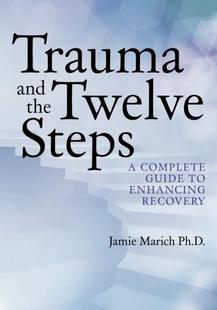 In her first job, as a young addictions counselor, author Jamie Marich was told “not to complicate matters” by addressing the history of trauma that she was beginning to observe in her clients. This book, both inspiring and useful to professionals, sponsors and people in recovery, is a response to her persistent questioning of the “one size fits all” approach often favored in twelve-step recovery programs. “Rigid adherence of the disease model of addiction and near-fundamentalist adherence to Twelve-Step philosophies can hurt more clients than they can help,” says Marich. Although she incorporates the twelve-step approach in addictions treatment, where she feels it is rigid and risks causing harm, she offers an adjunct model. This model includes building a safe container in the therapeutic relationship, providing self-soothing tools like breathing exercises and relaxation techniques, and when the client has sufficient sobriety, addressing the trauma in a body-oriented modality like the bilateral stimulation inherent in EMDR.
In her first job, as a young addictions counselor, author Jamie Marich was told “not to complicate matters” by addressing the history of trauma that she was beginning to observe in her clients. This book, both inspiring and useful to professionals, sponsors and people in recovery, is a response to her persistent questioning of the “one size fits all” approach often favored in twelve-step recovery programs. “Rigid adherence of the disease model of addiction and near-fundamentalist adherence to Twelve-Step philosophies can hurt more clients than they can help,” says Marich. Although she incorporates the twelve-step approach in addictions treatment, where she feels it is rigid and risks causing harm, she offers an adjunct model. This model includes building a safe container in the therapeutic relationship, providing self-soothing tools like breathing exercises and relaxation techniques, and when the client has sufficient sobriety, addressing the trauma in a body-oriented modality like the bilateral stimulation inherent in EMDR.
In particular, Marich advocates a trauma-sensitive approach to steps four and five. She finds the self-assessment of taking a moral inventory in step four and then admitting our wrongs when applied without trauma-sensitivity in step five can further injure an individual in recovery with a history of trauma who is already carrying a heavy sense of shame. Most victims of sexual trauma blame themselves, taking on responsibility for their abuse. Steps four and five can further perpetuate feelings of unworthiness, and, as Marich points out in a case study, this can be the place when working the steps that well-intentioned individuals consistently relapse. When you believe you are responsible for the abuse, the moral inventory is too painful to bear.
Marich provides an easy user’s overview of the psycho-neuro-biology involved in trauma. In the chapter called “Trauma 101,” she makes it clear that emotional wounds need to be treated and that when left untreated, just like a physical wound, they only get worse. We self-medicate to diminish the pain.
There is much to recommend this book for those in recovery and for professionals working in the addictions field. The narrative is rich with stories about clients in recovery, written from the passionate point of view of one who knows the territory and has become a leader in the field. Marich includes relevant research, theory, case studies, along with numerous mind-body resources, and exercises and self-inquiry questions for both individuals in recovery and the professionals who serve them.
Review: iRest® – Yoga Nidra for Kids At Bedtime and Quiet Time (CD)
by Jeanne Dillion
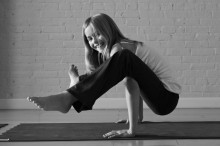
Jeanne Dillion, is the diirector of a therapeutic yoga studio in Boise, Idaho, a Certified Yoga Therapist and a Certified iRest® Teacher, who has studied with psychologist and yogi Richard Miller. Dillion offers yoga nidra (deep yoga relaxation) iRest practices on her website for adults. However unique to the iRest yoga nidra genre, are her practices for children. What parent or grandparent wouldn’t appreciate a gentle way to ease the active child into a calmer frame of mind or a good night’s sleep? The 20 minute practice moves through the iRest protocol and includes awareness of sensation, breath, and a joyful dip into bliss– “a great big heart of love that’s inside and outside and all around you”–before sending the practicing child off to sleep–“My body and mind are sleeping now, all through the night.” The practice prepares the child for sleep, and for waking up in the morning feeling rested, remembering the “special, happy, peaceful, true part of me that is always here.” Dillion guides the practice with the child comfortably tucked in, under the covers, with total permission to fall asleep. Adults can certainly do this practice, too, but would need to modify the breath count, as Dillion appropriately leads the breath faster for children’s smaller lung capacity.
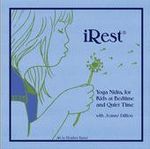 In the ten minute iRest called “Green Grassy Meadow,” Dillion uses guided imagery–the meadow, an eleven step golden staircase in which she leads the listener down, one step at a time on each exhalation. At the bottom of the stairs is a scene of animals by a pond. The variety of images, along with a specific question to the listening child, “Do you see other animals in or around the pond”? would likely keep the listening child alert through most of the practice. Towards the end of the track, the sun is setting and all the animals are going to sleep. Dillion cues the listening child to sense her own tired feeling and to settle in for a rest. This CD is a gift for both parents and children. Try it together at the end of a busy day! You can order the CD by mail from Dillion’s website or download the mp3.
In the ten minute iRest called “Green Grassy Meadow,” Dillion uses guided imagery–the meadow, an eleven step golden staircase in which she leads the listener down, one step at a time on each exhalation. At the bottom of the stairs is a scene of animals by a pond. The variety of images, along with a specific question to the listening child, “Do you see other animals in or around the pond”? would likely keep the listening child alert through most of the practice. Towards the end of the track, the sun is setting and all the animals are going to sleep. Dillion cues the listening child to sense her own tired feeling and to settle in for a rest. This CD is a gift for both parents and children. Try it together at the end of a busy day! You can order the CD by mail from Dillion’s website or download the mp3.
Review: Mudras for Healing
by Joseph & Lilian Le Page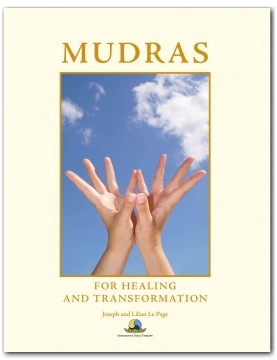
Joseph and Lilian Le Page have released their long-awaited mudra book, a labor of intense exploration and love, based on the traditions of Tantric and Hatha Yoga and their own deep practice. Mudras for Healing is the culminating compendium of 108 hasta mudras (hand gestures) , their specific health and spiritual benefits, their contradictions, and meditations and affirmations that put them to best use. The book will take its place as a classic in the yoga literature, as a resource for yoga students, therapists and educators interested in the therapeutic application of yoga. In fact, in this reader’s opinion, Yoga Mudras for Healing has the potential to change the face of the way most yoga is practiced in the West from its emphasis on what in India is referred to as “physical culture,” to a practice that has as its aim a fully realized life.
The book takes its clear organization from the kosha model, the five sheaths that define the dimensions of our human existence, from the physical body through the bliss body (the experience of our eternal and intimate true nature as divine). The authors investigate each kosha to discuss the systems by which we analyze and treat our imbalances. For example, in the Annamaya kosha dimension (physical dimension) there are nineteen mudras for specific health challenges, 6 to balance the five elements, and four for Ayurvedic healing.
The Le Page’s made all the right choices in creating this book. Each section of chapters relating to its kosha begins with an illuminating introduction that combines historical reference, tradition and practice. Each mudra is given a two-page spread. The illustrations by Sergio Rezek and Carlos Eduardo Barbosa are stunningly beautiful and precise. The authors and illustrators have created a symbol system that gives quick access to the essential information. One look at the symbols on the first page of each mudra section tells you which of the twelve physical systems may be balanced, in which direction the mudra directs the energy (vayus), which chakra is likely to be balanced, and which Ayurvedic dosha is affected. There is a clear graphic that depicts on a scale of 0 to 10 the level of energy the mudra is meant to stimulate or calm. In equally clear prose, the Le Page’s discuss the core quality of each mudra and where the hand gesture directs the breath in the body. In the interpretive text, the Le Page’s list the benefits and other mudras with similar effects. Practice instructions accompany the harmonious and detailed drawings. The second page of each mudra section offers a guided meditation that concludes with an affirmation invoking the mudra’s core quality.
Every element of this book is well-considered, including the appendices that illustrate mudras for the primary yoga postures, the principle pranayama and the most common mantras. Yoga therapist and physical therapist Matthew Taylor, PhD, ERYT-500, contributes an article suggesting directions that research may take in order to validate the effects that tradition assigns each mudra.
Mudras for Healing is a book to keep by your yoga mat or cushion so that you can integrate and expand your practice of asana (postures), pranayama (breathing) and meditation practice with mudras. It’s a book to take on retreat to explore the deeper dimensions of your own spirit and awaken all aspects of your being. And finally, it’s a book to keep on your shelf as reference as you work with your own imbalances and health challenges and to share with those you serve. There are a few books I carry with me everywhere. Mudras for Healing is now one of them. To order your copy please click here.
News: LifeForce Yoga Launches New Blog
In late May we launched the LifeForce Yoga blog which includes research, reviews, free practices, and guest blogs from other yoga and mental health professionals. Please make sure to visit the blog to catch up on our latest posts!
Events Calendar
Click above to review our updated Calendar of workshops and trainings!
I started practicing Ashtanga in March 07. I was overweight (94 kilo), unfit and certainly not flexible. I’ve never been to an Ashtanga or any other yoga class (I’ve since been to a shala twice). I’ve learnt from books and videos and blog comments. I’m now 78 kilo, feel fitter, stronger and much more flexible. This blog originally dealt with my obsession with achieving the Jump back ( later dropbacks, kapo, karandavasana 3rd series etc). In June 09 I found Srivatsa Ramaswami’s Complete book of Vinyasa Yoga and spent the next year working out here how best to combine it with my Ashtanga practice. I attended Ramaswami’s 200 hour Vinyasa Krama TT course in July 10 and now have a Vinyasa Yoga at Home Practice Book available on Kindle that lays out Ramaswami’s Sequences and subroutines. After trying to balance the two styles of practice for the last couple years, I’ve recently begun to explore the ‘Original’ Ashtanga Vinyasa Krama in Krishnamachray’ s Yoga Makaranda and Yogasanagalu and to find a consistency in his early and later teaching.
Always something wonderful to read what you’ve sent us! You are such an inspiration! I printed up the PDF for the study on yoga vs aerobics and am anxious to read it! Much love, Elizabeth